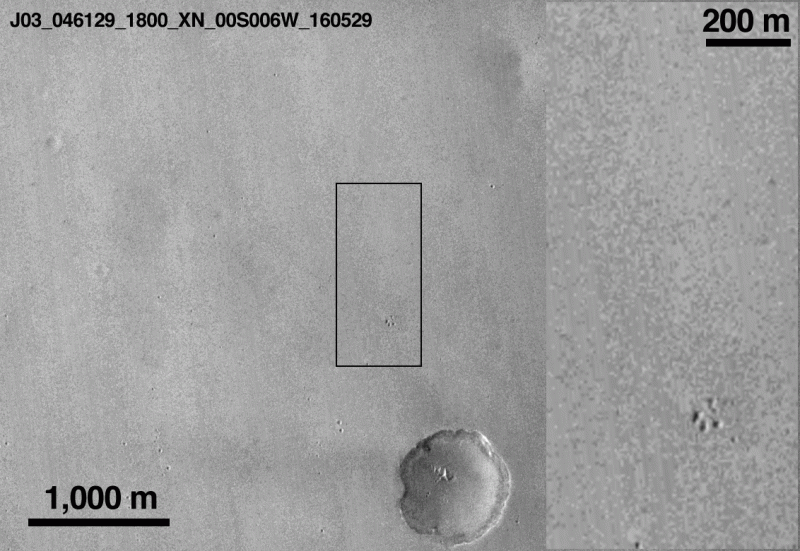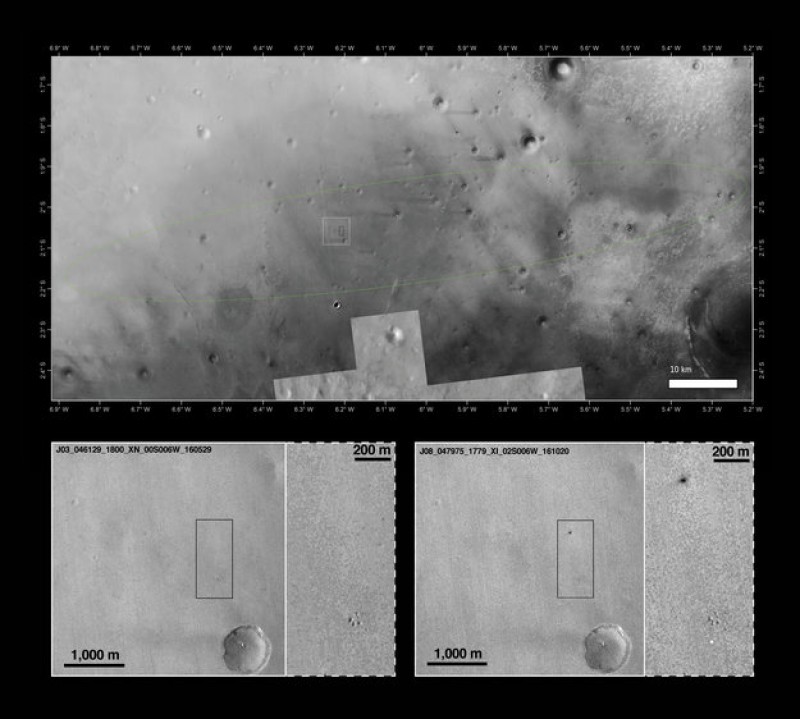 |
| A cool GIF of NASA Mars orbitor photos showing the Schiaparelli crash site. |
The Mars lander EDM Schiaparelli, a joint project of the European Space Agency and the Russian space agency Roscosmos, was designed to test soft landings on the Red Planet. In October of 2016, it was supposed to touch down softly and begin transmitting data from the few scientific instruments on board. That didn’t work. Basically, it augered in hard and all signals were lost. Such are the fortunes of space exploration.
But that is not quite the end of the story. NASA’s Mars Reconnaissance Orbiter has found the crash site.
Data recorded by Schiaparelli’s mothership, the Trace Gas Orbiter, are currently being analyzed to understand what happened during the descent sequence.
In the meantime, the low-resolution CTX camera on-board NASA’s Mars Reconnaissance Orbiter (MRO) took pictures of the expected touchdown site in Meridiani Planum on October 20 as part of a planned imaging campaign.
The image released today has a resolution of 6 meters per pixel and shows two new features on the surface when compared to an image from the same camera taken in May this year. One of the features is bright and can be associated with the 12-m diameter parachute used in the second stage of Schiaparelli’s descent, after the initial heat shield entry. The parachute and the associated back shield were released from Schiaparelli prior to the final phase, during which its nine thrusters should have slowed it to a standstill just above the surface.
The other new feature is a fuzzy dark patch roughly 15 x 40 meters in size and about 1 km north of the parachute. This is interpreted as arising from the impact of the Schiaparelli module itself following a much longer free fall than planned, after the thrusters were switched off prematurely.
Estimates are that Schiaparelli dropped from a height of between 2 and 4 kilometers, therefore impacting at a considerable speed, greater than 300 km/h. The relatively large size of the feature would then arise from disturbed surface material. It is also possible that the lander exploded on impact, as its thruster propellant tanks were likely still full. These preliminary interpretations will be refined following further analysis.
 |
A closer look at these features will be taken next week with HiRISE, the highest-resolution camera onboard MRO. These images may also reveal the location of the front heat shield, dropped at higher altitude.
Since the module’s descent trajectory was observed from three different locations, the teams are confident that they will be able to reconstruct the chain of events with great accuracy. The exact mode of anomaly onboard Schiaparelli is still under investigation.
The two new features are located at 353.79 degrees east longitude, 2.07 degrees south latitude on Mars. The position of the dark mark shows that Schiaparelli impacted approximately 5.4 km west of its intended landing point, well within the nominal 100 x 15 km landing ellipse.